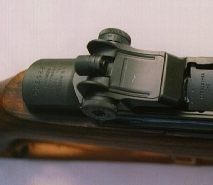


For the formal process of "Targeting," go here.
The starting point for windage zeroing your M1 or M14 is to get a "no-wind" windage zero. Center your rear sight according to the index marks on the receiver and sight base. Center the front sight in its dovetail (loosen the Allen-head screw, of course) as best you can by eye. Using a pencil, draw a witness mark on the sight & base. Fire a group at 100 yards (under "no wind" conditions, of course!). If your group is not centered, loosen the front sight and move it opposite to the direction you want the group to move. Continue to fire and adjust until your group is centered. You may, of course, have to put a click or three on the windage if your front sight starts to overhang the sight base. If you find that your front sight is "way too far" over, you may have a bent barrel or other problem; consult with Clint.
For elevation, start with eight clicks up from the bottom at 100 yards. Each click (either windage or elevation) with standard sights is 1 MOA, so one click will move you one inch. Typically you'll come *down* one click at 200 yards. If you can, confirm your zero at 200 yards; this will allow you to loosen the screw in the elevation knob and turn the knob so that the "2" mark is opposite the index on the sight base.
A quick & dirty "battle zero" may be obtained by zeroing 1.25 in up from the point of aim (for .30-'06) at 25 yards. This zero should allow its on man-sized targets form 0 to 400 yards.
If you have "National Match" sights, there are only two differences between Service and NM sights.
First, the windage clicks yield 1/2 MOA (1/2" per 100 yards), assuming you have an NM base and windage knob.
Second, the NM hooded aperture is on an eccentric, so that while the elevation knob still gives you 1 MOA (1 inch per 100 yards), rotating the aperture 180 degrees changes the elevation 1/2 MOA. See
for the details on how that works.
Except for the "finer" adjustments (twice as many windage clicks to move the point of impact a given distance, for example) the procedure is precisely the same.
--Walt Kuleck